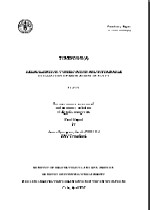
 | REHABILITATION, CONSERVATION AND SUSTAINABLE UTILIZATION OF MANGROVES IN EGYPT |
![]()
MINISTRY OF AGRICULTURE & LAND RECLAMATION
MINISTRY OF STATE FOR ENVIRONMENT
FOOD AND AGRICULTURE ORGANIZATION OF THE UNITED NATIONS
Cairo, April 2002
ANNEX II - COMMENTS ON THE TOTAL ECONOMIC VALUE METHODOLOGY USED TO VALUE EGYPT’S MANGROVES
LIST OF TABLES
Table 1 Socio-economic roles of Egypt’s mangroves
Table 2 Summary of current and potential values of Egypt’s mangroves
Table 3 Impacts to Egypt’s mangroves and key values affected
Table 4 Environmental valuation techniques
Table 5 Key benefits arising to different stakeholders groups from Egypt’s mangroves
Table 6 Ras Mohammed land recreation value of mangroves
Table 7 Ras Mohammed sea recreation value of mangroves
Table 8 Nabq recreation value of mangroves
Table 10 Egyptian fish catch dependant on mangroves
Table 11 Potential national non-use value for Egypt’s mangroves
Table 12 Potential visitor non-use value for Egypt’s mangroves
Table 13 Impacts on Egypt’s mangroves and key values affected
Table 14 Summary of current and potential values of Egypt’s mangroves
Table 15 Estimated Total Economic Value of mangroves at Ras Mohammed and Nabq
LIST OF FIGURES
Figure 1 Total Economic Value framework
Figure 2 Total economic value of mangroves
Figure 3 Relative importance of the different values of Egypt’s mangroves
LIST OF ACRONYMS
BCR................................................. Benefit to Cost Ratio
CBA................................................ Cost Benefit Analysis
CS......................................................... Consumer Surplus
EEAA............... Egyptian Environmental Affairs Agency
FAO........................... Food and Agriculture Organization
GEF..................................... Global Environment Facility
NPV...................................................... Net Present Value
PS........................................................... Producer Surplus
TCM.................................................. Travel Cost Method
TEV............................................... Total Economic Value
WTP..................................................... Willingness to Pay